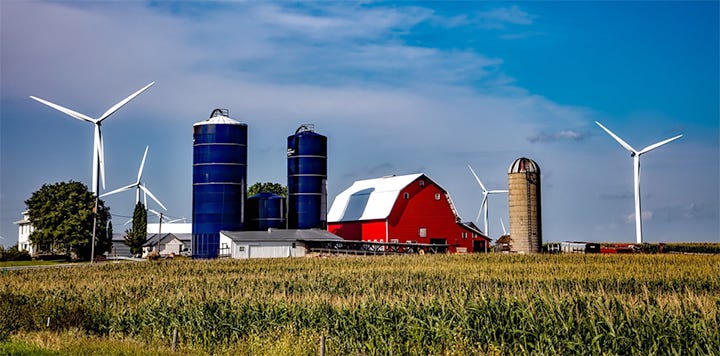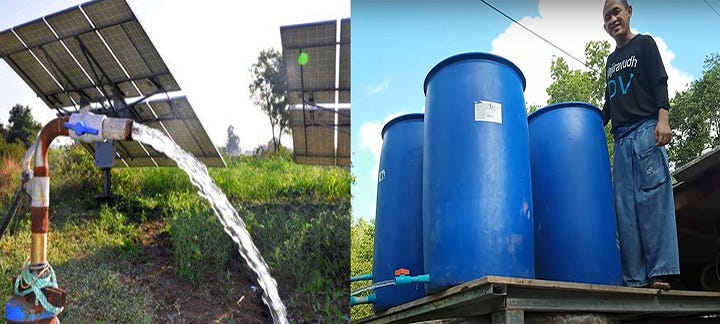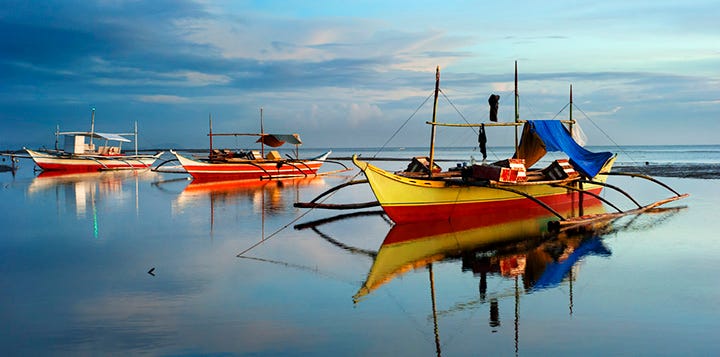April 29, 2024
Good morning, Free Thinkers.
Last time I covered supply chain exploits as a prime example of 5th Gen Warfare. Today I want to draw a bullseye around water and electricity, and their real or imagined scarcity. I have followed this hand-wringing crisis over the decades -- and experience it firsthand in the Philippines -- and so feel compelled to add some observations for your gray-matter processor. Because a certain faction of people are nearing psychosis levels of angst about it all, when traditional solutions are well known. So let’s state a couple of terms, since the apparent lack of water in many places is traditionally defined by either physical or economic scarcity.
Physical scarcity of water derives from actual rainfall and ecosystem, i.e. the Sahara desert. Mankind has been smart enough usually to avoid building large population centers in such places. Usually. But they exist, think Southern California, or the NEOM project being built in Saudi Arabia. With enough willpower and engineering, you can overcome physical scarcity, for example cities like Dubai with its massive desalinization plant. California used to be able to overcome its rainfall deficit, but we’ll get back to that.
Economic scarcity is essentially lack of infrastructure, or poor management. A typical day here in Visayas in April (the Hot Season) involves most of the locals trying to fill buckets of water from dry faucets in their homes. Failing that, they trek on their motorcycles with empty containers to one of several local public wells. Imagine doing that a few times every day just to flush the toilet. Don’t we have municipal water? Yes we do, along with about sixty-eight inches annual rainfall, but municipal water here is under-sized and not reliable. It has been this way for decades, and people are either too poor or apathetic to change it.
To contrast, I spent some years in the Mojave desert back in the ‘80s. Despite only six inches annual rainfall where we lived, the town never ran out of water. We sprinkled our lawn frequently; only possible because of good infrastructure and management. Yet modern California has nothing but crisis after crisis related to water, thanks to decades of crazy people, the Water Resources Control Board, and the dam dismantling movement that has been going strong since the ‘80s. The list of dams already removed and proposed to be removed is staggering. California would rather turn back the clock to the days of the Settlers rather than actually manage the resource. Or is this an example of 5th Gen Warfare?
Strategic Scarcity, then, must be added to the lexicon: the deliberate mis-management or destruction of a resource to ensure inadequate supply, as in California. The result is all of those people and farms getting their water more frequently from the ground; hence the declining water table. So now access to the water becomes a choke point that can be controlled. You can’t dig a new well. You can’t pump more than X-number of gallons, etc. The Climate Faithful would have you believe it is man’s harm to the environment that has raised the temperature and dried up all those faucets. Shame on us for selfishly abusing this precious resource... I know you see how the programming works, Reader.
Vulnerabilities of Municipal Water
Now you may be sitting on the deck of your suburban home, reflecting that you’ve never once had a problem getting water from the pipe. Let’s review the basic vulnerabilities associated with municipal-supplied water:
Controlled access. As with electricity, most people can only access water that comes through a paid meter. What happens when you are no longer a Good Citizen, or fail to get your 10th vaccine? Remember this essay when that point arrives.
Water additives. Flouride is still a hot debate after all these years. Regardless of its efficacy, do you really trust scientists to suggest what should be added to your water? In 2024? What else might they decide you need to ingest?
Failing infrastructure. Flint, Michigan says it all. The municipal system may not just fail one day, but slowly poison you over years. The US in particular is not so great about maintaining old infrastructure, and drinking out of the tap may not be the best idea any more.
Attack risk. We don’t need government reports to know that reservoirs and aquifers are vulnerable to attack. What damage could a hostile weather balloon flying across the American heartland cause? The system is vulnerable, period.
At least three of those vulnerabilities are 5th Gen Warfare vectors. If the Chinese, Russians, Mossad, or CIA are who you distrust most, then just imagine literally anyone being able to carry out a water-related attack. Hello, fentanyl in the reservoir. Cyber attacks are already a thing. “Us and them” becomes a silly game when you can take positive steps to secure your own water, Readers. There will be a mass attack to the water supply eventually, and reacting to it afterward will just put you in panic mode. One thing we should have learned in the last four years is to avoid panic mode.
Municipal Electricity
If the water system is slowly angling toward a choke point in supply, then the electric grid is already there. Just pick from the numerous examples: Wind farm failures in Texas tripping the regional grid; rolling brown-outs in major population centers all over the world; mysterious fires that seem to attack the US whenever it is convenient, always near power lines; Smart MetersTM that are set up to control or penalize your electric access; the transparent push to phase out petro-fuels; and on and on.
What makes this an example of 5th Gen Warfare is the concerted lack of [upgrades to the grid], despite piling-on a trifecta of load increases: 1) population growth, 2) electric vehicles, 3) data usage like “AI” and crypto mining. It is clearly a recipe to limit electricity access, or at least to provide a source of political debate to thwart progress. Good Citizens will of course have no problems getting the electricity they need, but let’s think more maliciously:
Lack of upgrades has also left the power grid increasingly vulnerable to attack or misuse. Bad actors who are inclined to seriously disrupt power distribution, or to remotely light some fires, would not have to try very hard; which is why you should plan on it happening. I am one of those crazy people who think there is a lot more to the Maui fires than the official story. Maybe it is because random electrical fires are a perfect cover for malicious fires started by drones or energy weapons. Maybe it was the videos of fireballs traveling down the power lines in Lahaina. Maybe it is the fact that search-engine results on the subject are flooded with “fact check” articles debunking the whole idea. OK you beat me. But that is exactly why this is 5th Gen Warfare.
But wait, Visayas, what about all those solar and wind farms?
Glad you mentioned them, Reader. I am a fan of alternative energy because it should make us less dependent on a centralized power grid. It can be done as-needed on a small scale, and can be perfect for remote villages or just the average homesteader like myself who wants self-reliance. But what we see instead are huge solar and wind farm projects, vulnerable to many of the same things as the grid itself. Never mind the significant problems of maintenance, environmental damage, and lifespan. As far as I know they are huge capital resource expenditures that do not pay for themselves, rather like electric cars.
We have a wind farm here in Visayas on one of the smaller islands. Visit there and you’ll see about 20% of the mills not turning. Their power generation is not tied to the local grid at all, but rather sent under the strait to Iloilo City: local residents still pay standard rates, and suffer the same power outages as everyone else.
But we also have a solar farm on another island, and as far as I can tell it provides a meaningful contribution to the local power utility, which supplies a nearby city. I’ll call that one a win, but it has only been in operation since 2018. My guess is it will gradually break down and not get maintained, like most other infrastructure here, but I hope I’m wrong.
The Men Who Built America must be rolling over in their graves, knowing we can’t even keep the lights on in Texas and California. It is 2024, but you need to be thinking about how to secure your electricity supply. We should have neighborhood small reactor plants by now, but seem determined to keep the human race from advancing. I find it all rather dystopian, but what can we do other than prepare accordingly?
Diversification is the Antidote to Scarcity
When single sources become unreliable, you need to diversify. At our place, we will probably stay attached to the electric grid, but add our own solar until we can fully cut the cord. If you own an electric car, there is a good chance you have a petrol car as a backup. We intuitively know these things, like not investing in a single stock but spreading the risk over multiple sectors. But strangely, we often don’t consider backups for our most crucial needs like water and power.
DIY videos are a wealth of information on this topic. You can build your own backyard catchment tank, like a guy in Texas. Since the local municipality would not allow him to drill a well, he rigged up a huge rainwater system that was within the zoning regulations. There is a guy in Thailand or Vietnam with a DIY filtration system that I hope to emulate. It is cheap, and effective. Commercial systems are available for the non-DIY’ers; the important thing is to have options.
Personally I would not be opposed to digging an illegal well on land that you OWN, to secure a vital resource. But the other option for those of you with restrictions is just moving somewhere that will allow it. An ideal solution might be a well, combined with a large cistern...come to think of it, that is exactly the way our forebears did it. Consider a manual backup pump for whenever the electricity is out, or even a windmill pump. My plan is to rig up a gas-powered 125cc motorcycle engine for such occasions.
For electric power there are battery or flywheel storage systems that can be sized to provide whole-house power for the length of time you determine. There are home wind-power and even geothermal solutions that can augment solar. For those of you with a flowing stream on your property, water turbines could be a way for you to generate power. There are biomass gasifiers. Some people are even powering their homes with their hybrid cars in a pinch. Hey, why not use these modern systems to their best advantage?
In conclusion, the attack vectors of 5th Gen Warfare are unexpected by design. I do not wish to be a leaf on the wind, blowing from crisis to crisis, nor do I wish to just throw up my hands and be a pawn in the system. ‘Prepper’ was a word that got thrown around with derision 20 years ago, but those guys had a lot of the right ideas. To remain an independent thinker, we need to secure access to certain necessities, if for no other reason than to remain viable in the fight.
For me, learning to really trust in the Lord and his leading is the key to peace of mind. Not just peace of mind, but the right frame of mind. I’ll gladly be a slave to Him, but not a slave to Babylon. That is why we live this life; it is more than being closer to God, it is also being disconnected from the Beast System. As much as we can, anyway. I don’t know where your mind is Readers, or your spiritual beliefs. For me, there is a great deal of freedom found in giving up the life I used to have, but I know it is not for everyone. I pray that wherever you are, or wherever your travels take you, that you can know what it is like to follow the only One worth following, Jesus Christ.
Scarcity is the same story all around the globe. Whether it is baby formula, milk with supposed avian flu, access to helpful meds like Ivermectin during a pandemic, etc. You name it, and they want it to be scarce. From gasoline to breathable air, from chicken to drinkable water, you are just another commodity in this Human Industrial Complex. So get your head screwed on straight, wake up, and take a look around. That is my Visayas Outpost advice for you today, Readers. There are things to do in this 5th Generation War, so you better get started.
Peace be upon you in Christ from the Philippines,
Visayas Outpost







Hi friend, thanks for your insights and warnings. This is the first I have read anything by you. I too live in the Visayas, on Siquijor island. Like most places we are in a drought, which seems to happen in cycles, so water is an issue. It is ALWAYS an issue on a small island, but the politicians have no problem encouraging development to line their pockets. More development leads to excess strain on the electrical grid which is mismanaged at the expense of the citizens. This is not a new condition. It has been an issue since I moved here 12 years ago, but every administration ignores it to the point it cannot be denied. So, their solution is to blame it on El Nino. Read below a comment I posted in the Siquijor Forum, which pretty much sums it up. The one thing I believe is that solar is not available to 99% of the population of provincial citizens which are impoverished, and that on an island wide level it will be too expensive and subject to grift, corruption and mismanagement.
People still don't understand that solar is NOT going to save Siquijor in the near or distant future. The cost of planning, purchase and installation of solar panels will be a long term project, wasting time while Siquijor burns. Keep in mind there are two sides to solar energy: first, the generating and converting solar power to electricity and secondly the storage of the energy which requires expensive arrays of not-very-efficient batteries.
Recently, the governor has been forced to acknowledge that Siquijor has an electrical distribution problem. What a surprise!! Like it hasn't been evident for a decade or more. However, the governor, like all governors before him, refuses to take any responsibility for the problem. Instead, he claims that the problem is complex and requires a number of complex and time consuming solutions, so not to expect any relief in the near future.
Moreover, the government conveniently places much of the blame on El NINO,
as an act of GOD. EL NINO is an aberrant weather pattern that, from time to time, causes droughts = more electricity demand = overload of the generators = burnout of electrical distribution = frequent and continuous brownouts. El NINO, on the other hand, can also cause extended periods of rain storms, which do not create more electricity demand or overload of the generators or burnout of electrical distribution or more frequent and continuous brownouts. However, the "brownouts” frequency during the rainy season is not much diminished. The government, by blaming El NINO on an act of GOD, would suggest that the only solution is to pray for celestial intercession rather than government action. This is nothing more than a convenient distraction from the real cause and effective solution.
It seems rather odd to suggest that there is no easy fix or solution while, at the same time, approving ever more development schemes guaranteed to increase the electrical demand as well as the need for more tax funded infrastructure to support development. This policy completely ignores that Siquijor needs to appropriate the necessary funds to purchase a 3rd GENERATOR while upgrading the existing 2 generators that are long past their generating prime. This alone would create relief in the short term, while giving Siquijor breathing space to explore alternative energy solutions in the long term. So, the question remains, why is there no political will to acknowledge and move forward with this most obvious and easily available solution?